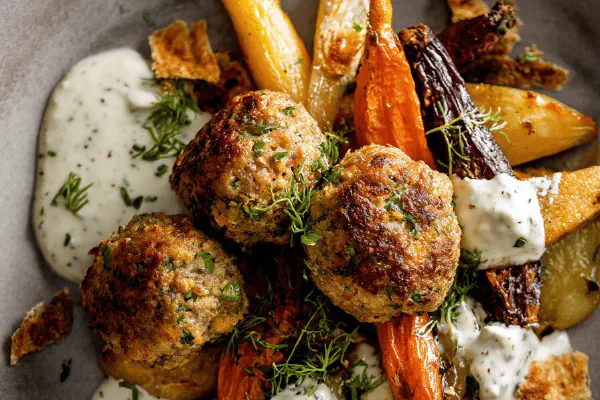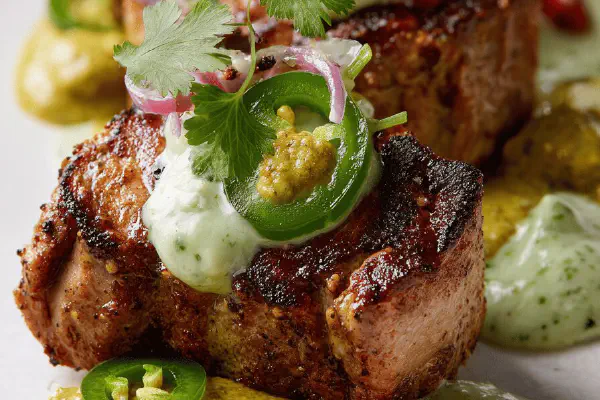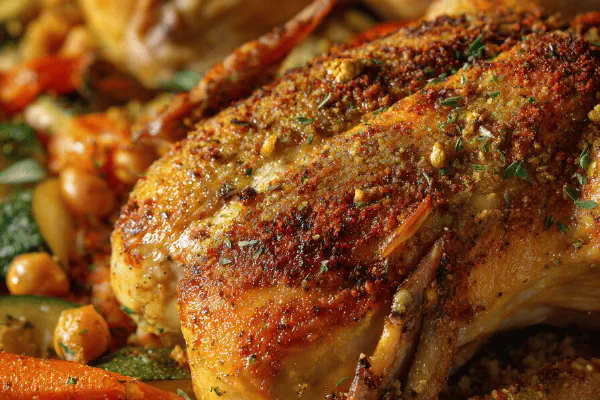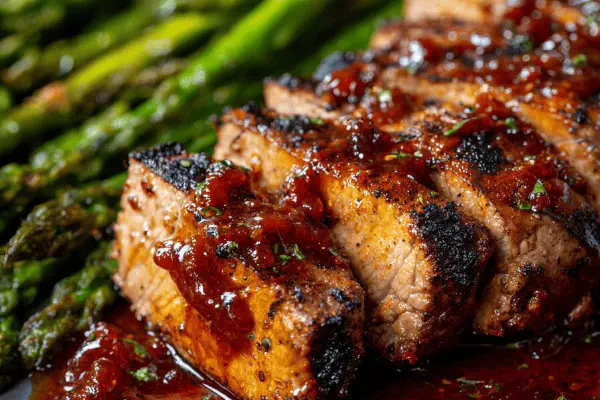Sheet Pan Pork Chops
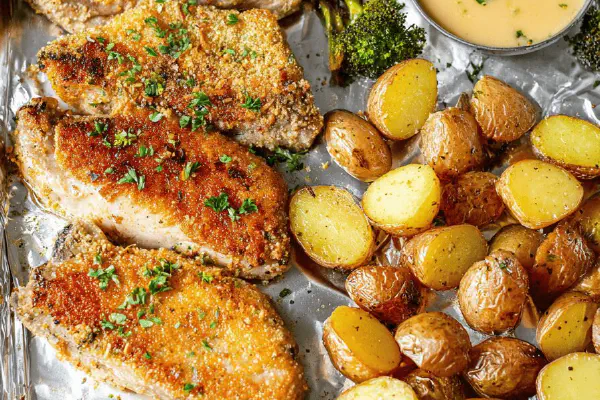
By Emma
Certified Culinary Professional
Ingredients
- 4 pork chops, about 1 inch thick
- 5 small Yukon Gold potatoes, washed and halved
- 3 tablespoons unsalted butter, melted, divided
- 1/3 cup grated Pecorino Romano cheese, divided
- 1 teaspoon garlic powder
- 1 teaspoon smoked paprika
- Salt and freshly ground black pepper to taste
- 1/2 cup all-purpose flour
- 1 large egg
- 3/4 cup panko breadcrumbs
- 1 head broccoli, cut into florets
- 2 tablespoons olive oil
- For sauce: 2 tablespoons Dijon mustard, 1 tablespoon honey, 1 tablespoon mayonnaise, splash lemon juice
About the ingredients
Method
- Start with oven at 430°F. You want it hot to crisp those potatoes and pork skin right.
- Line a baking sheet with foil, spray lightly—don’t skip, sticks kill all good bite.
- Potatoes first. Halve and score them if you want, makes ridges catch butter and crisp up. Lightly spray foil to help with roast and ease cleanup.
- Build a potato packet: toss those potatoes with 2 tablespoons melted butter, half the Pecorino Romano, garlic powder, smoked paprika, salt, and pepper. Mix well so every side kissed with fat.
- Place scored sides down neatly, pour remaining butter melted over. Pop in the oven for about 12 minutes. You want edges browning, centers just starting to steam through. Use color and smell, rich toasted butter aroma signals readiness.
- While those bake, dry pork chops thoroughly. Damp chops = soggy crust, no good. Season with salt and pepper both sides.
- Set dredge: flour in one bowl, beaten egg in second, panko mixed with remaining Pecorino Romano and smoked paprika in third. Dunk pork chops in flour, shake off excess (too much flour clumps when cooking), dip in egg quickly so no excess runs off, then coat in breadcrumb mix, pressing crumbs on top for crust surface.
- Broccoli: toss with olive oil, salt, pepper. Don’t drown them; just a shiny coat.
- Wire rack trick: If you have a greased wire rack, place it over foil-lined sheet. Pork chops and potato packet go here. Air circulation underneath keeps pork chops crisp bottom, prevents them going rubbery from sitting in fat.
- Remove potato packet from oven, carefully open foil to expose potatoes. Place pork chops on wire rack or directly on pan if no rack. Scatter broccoli around pork.
- Return to oven. Roast for 12-17 minutes. Watch broccoli edges for charring and crispy snap, potatoes should be soft inside, test by poking with fork. Pork chops hit 145°F internally; use instant read thermometer. Don’t guess here, dry chops kill the mood. Undercook a bit if unsure, carryover heat finishes the job.
- While baking, whisk honey mustard sauce: Dijon mustard, honey, mayo, splash lemon juice. Adjust balance to taste—bright, sweet, tangy. Serve on side to dip pork. Adds needed moisture contrast.
- Pull everything out. Potatoes golden with crisp edges, pork crust crunchy and deeply browned, broccoli vibrant green with browned tips. Smell? Butter, garlic, roasted pork, tangy honey mustard. Sounds from pan? Slight sizzle fading to silence means time to eat.
- Eat immediately. Pork chops best hot, crust softens quickly. Leftovers? Potatoes reheat well, pork chops turn dry—better cold in salad or reheated carefully with foil tied loosely.
Cooking tips
Chef's notes
- 💡 Oven heat matters. 430°F hits the crisp edge fast, hotter than usual. Watch potato edges browning; butter aroma signals roast near done. Don’t skip foil spray or potatoes stick—cleanup nightmare. Butter divided seals moisture inside, but also helps crisp outside. Potato scoring optional but makes crisp edges quicker. Flip scored side down for max browning. Timing potatoes first, then pork and broccoli on wire rack traps air. Keeps chops crisp underneath, stops soggy crust. Learned hard with soggy bottoms on earlier tries.
- 💡 Pork drying is key; no wet chops no soggy crust. Use paper towels and be thorough. Season chops well both sides, salt and pepper penetrate better when dry. Flour dusting first for egg adhesion, shake off excess or lumps burn. Egg quick dip; too much runs off, crumbs slide off later. Breadcrumb mix pressed firmly into pork surface; crumbs fall off if light coat. Mix panko with Pecorino Romano and paprika to add sharpness and smoky depth. Can swap paprika for cumin if preferred. Herbs like thyme or dill can also go in crumb mix for variety.
- 💡 Broccoli cooks faster; toss last right before roasting. Light olive oil coat, salt, and pepper only. Don’t drown; mushy broccoli ruins texture contrast. Add on pan after removing potato packet. Scatter around pork chops to catch juices but ensure no overcrowding. Watch broccoli edges for charring signals. Crisp snap means done; limp means underdone or oversteamed. Can swap broccoli for other quick roast veg if preferred. Wire rack allows air below chops, essential for crispy underside. If no rack, expect softer bottom crust.
- 💡 Honey mustard sauce quick whip while pork roasts. Dijon mustard, honey, mayo for creaminess, splash lemon juice for brightness—adjust balance for your taste. No mayo? Greek yogurt works or skip for sharper tang. Serve on side to avoid soggy crust. Sauce adds moisture contrast to dry pork crust. Use instant read thermometer for chops target 145°F internal. Carryover heat finishes cooking. No thermometer? Press test works; should bounce back slightly but firm. Overcooking dries texture; undercook slightly better than over.
- 💡 Watch pan moisture. Excess liquid means oven temp low or crowding pan. Foil packets trap steam for potatoes but scored edges help crisp. Remove potato packet before adding pork and broccoli to prevent steaming. Timing multitask: potatoes soften first then pork and broccoli roast together. Roast 12-17 mins but sensory counts more: listen for sizzle near chops, smell toasted butter and roasted pork aroma, watch for browned tips on broccoli. Rest chops 3-5 mins after removing, keeps juices inside. Leftovers reheat differently; potatoes hold well, pork dries fast. Use pork cold in salad or wrapped loose foil reheated carefully.
Common questions
Best way to keep pork crust crispy?
Dry chops well before breading. Use wire rack under chops so air circulates. Avoid overcrowding pan makes crust soggy. Press crumbs firmly to stick. High temp oven helps brown crust fast. Rest chops after baking; juices redistribute. Skip foil directly under if rack present, traps moisture. Crust sogginess usually from moisture or low heat.
Can I replace Pecorino Romano cheese?
Yes. Parmesan works but less sharp, softer flavor. Harder aged cheddar or asiago could work too but adjust salt. No cheese? Butter and paprika in crumb mix gives some flavor. Cheese key for salty crunch though. Herbs added to breadcrumb mix change flavor—try thyme or dill if wanting twist. Panko crumbs optional - crushed toast or cornflakes can substitute but adjust cooking time for texture differences.
Why are potatoes soggy sometimes?
Usually lack of scoring or too low oven temp. Roasting high temp with butter helps crisp edges. Don’t crowd pan or leave uncovered moisture traps. Foil packet steam traps moisture but scoring potatoes allows steam to escape and edges crisp. Spray foil or lightly oil foil so potatoes don’t stick. Flip scored edges down for direct heat contact. Watch aroma of toasted butter. Undercooked potatoes feel mushy inside; poke test helps. Russets can dry faster but Yukon Gold preferred for buttery texture.
How to store and reheat leftovers?
Store potatoes and pork separately if possible. Potatoes reheat well in oven or toaster oven to regain crisp edges. Pork reheats best loosely wrapped in foil in oven low heat or eaten cold in salad to avoid drying. Microwave reheats dry pork fast. Broccoli reheats okay but can get soft and lose crispness. Sauce best stored separately, stir before serving. Leftovers last 3-4 days refrigerated. Freeze pork chops individually wrapped to retain moisture best.
